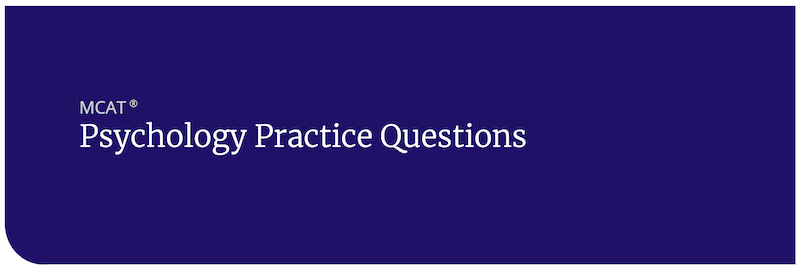MCAT Practice Questions: Psychology
The MCAT will present you with 10 passages on psychology, sociology and related biology topics, and ask 4-7 questions about each passage. The questions will address the four skills listed, although not every passage will require you to use each skill. You will be asked to answer 15 discrete questions that are not associated with any passage. These will also be designed to test both your science knowledge and application of that knowledge based on the four SIRS skills. You can find more details on what you need to know about the overall structure of the MCAT here.
The Psych/Soc section of the MCAT is scored on a curved scale of 118-132, with the median score of all test takers set at 125. A given scaled score does not correlate to any specific number of right or wrong questions. Instead, each test administration is curved according to its level of difficulty and the performance of the test-takers on that day. The score for this section of the test is combined with the other three sections to give an overall score ranging from 472 to 528.
MCAT Practice Questions: Psychology
Answer and Explanation
The correct answer is: C
The base rate fallacy occurs when prototypical or stereotypical factors are used for analysis rather than actual data. Because the student is volunteering in a hospital with a stroke center, he sees more patients who have experienced a stroke than would be expected in a hospital without a stroke center. Thus, this experience changes his perception and results in base rate fallacy. Deductive reasoning, choice (A), refers to drawing conclusions by integrating different pieces of evidence. The representativeness heuristic, choice (B), involves categorization and classification based on how well an individual example fits its category. Confirmation bias, choice (D), occurs when a person only seeks information that reinforces his or her opinions.
Answer and Explanation
The correct answer is: B
Bipolar disorders have been shown to be highly heritable and are associated with increased levels of norepinephrine and serotonin in the brain. Bipolar I disorder can be diagnosed with a single manic episode and does not require a major depressive episode. Bipolar II disorder requires at least one hypomanic episode and one major depressive episode. Cyclothymic disorder contains at least one hypomanic episode and dysthymia.
The AAMC has described the topics within the Psychological, Social, and Biological Foundations of Behavior section of the MCAT. These topics are subdivided into three Foundational Concepts, each of which has several sub-categories.
To learn about Foundational Topics 1-3, covered in the Bio/Biochem section of the test, click here, and Foundational Topics 4-5, covered in the Chem/Physics section of the test, click here.
You can also visit the AAMC site to learn more about the MCAT Blueprint.
The Foundational Topics for the Psychological, Social, and Biological Foundations of Behavior are:
6. Biological, psychological, and sociocultural factors that influence the ways that individuals perceive, think about, and react to the world.
6A. Sensing the environment
6B. Making sense of the environment
6C. Responding to the world
7) Biological, psychological, and sociocultural factors that influence behavior and behavior change.
7A. Individual influences on behavior
7B. Social processes that influence human behavior
7C. Attitude and behavior change
8) Psychological, sociocultural, and biological factors that influence the way we think about ourselves and others, as well as how we interact with others.
8A. Self-identity
8B. Social thinking
8C. Social interactions
9) Cultural and social differences that influence well-being.
9A. Understanding social structure
9B. Demographic characteristics and processes
10) Social stratification and access to resources that influence well-being.
10A. Social inequality
The most important factor you should consider about the Psych/Soc section of the MCAT is how well prepared you are for both the content and the critical reasoning required. To learn more about how to prepare for the test, click here.

